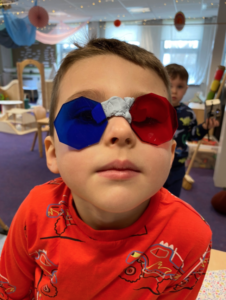We got some lovely new shapes for the light box and had lots of fun today using the shape spyglasses to find the correct shapes. The children loved using the shapes as glasses 🌈
Weighing in P12
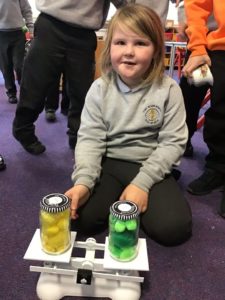 During our maths time today, we started talking about weight. We found it tricky at first to think about the different things we would need to weigh and why. After some discussion we realised we needed weight for cooking and some people like to weigh themselves too. We had a go at weighing ourselves and were amazed at how much Mrs Hannett weighed….we think she needs to stop eating biscuits in the staff room! We then used the balancing scales to see if we could find two things that weighed the same, this was really hard. In the end we worked together to estimate how many pieces of Kappla we needed to to balance a block.
During our maths time today, we started talking about weight. We found it tricky at first to think about the different things we would need to weigh and why. After some discussion we realised we needed weight for cooking and some people like to weigh themselves too. We had a go at weighing ourselves and were amazed at how much Mrs Hannett weighed….we think she needs to stop eating biscuits in the staff room! We then used the balancing scales to see if we could find two things that weighed the same, this was really hard. In the end we worked together to estimate how many pieces of Kappla we needed to to balance a block.
States of Water
We were super excited this morning that our orbeez that we had put in the freezer had frozen. 🥶 We enjoyed experimenting with them and we all chatted about different changes that water goes through. ⭐️ We are learning the different states of water (ice, water and steam) and using words to describe it. 👣 Our next steps are to continue using ice and experimenting with it inside and outside. Maybe we might even get some frost!
P234 TRIP TO THE FARM
P234 went to visit the RSPB farm at Gruinart. Here is a wee video from the trip. We had a fantastic time and it was very ;hands on” – much to the children’s delight. A huge thanks to the RSPB for organising such a great visit.
Buddy Session
This afternoon we had our second buddy session and we had a harvest tea. Miss Brown read us a story called Annette’s baguette to set the theme for the afternoon. The big ones taught the littles how to make bread as they have been doing lots of cooking in class of late and the littles shared the brambles they had harvested and turned into jelly once the bread was cooked. We then worked with our buddy to make a harvest card to be added into the harvest bags for some of the older people in our community.
Bramble Picking
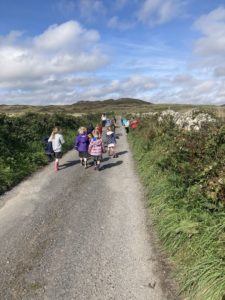 This afternoon we went to harvest some brambles along the Croft roads. We practised some road safety along the way, ensuring that we stopped, looked and listened before crossing the road and made sure our partners kept safe too. We worked in teams of 4 to collect as many brambles as we could. In total we collected over 1kg! Mrs Hannett took them home tonight and boiled them up with jam sugar before straining our the juice and pouring it into sterilised jars. Hopefully tomorrow we will be able to taste some bramble jelly with our buddies from P5/6/7 and make some bread to go with it too!
This afternoon we went to harvest some brambles along the Croft roads. We practised some road safety along the way, ensuring that we stopped, looked and listened before crossing the road and made sure our partners kept safe too. We worked in teams of 4 to collect as many brambles as we could. In total we collected over 1kg! Mrs Hannett took them home tonight and boiled them up with jam sugar before straining our the juice and pouring it into sterilised jars. Hopefully tomorrow we will be able to taste some bramble jelly with our buddies from P5/6/7 and make some bread to go with it too!Space
Since space is so big we have not scratch the surface of it in our topic because space is endless and I mean it.
There was a new mars rover sent to mars called Perseverance. Its task was to collect samples from Mars to test if there was life there and it was packed with the first space helicopter. But the Chopper could go at least 10 meters and it would be retrieved by another shuttle and come back to earth in 2032.
Since there will be more space helicopters. I only know of the next one called dragonfly but this one will have four props this time plus will fly longer distance. I estimate 20 or 30 or maybe it might be to heavy and it might fly 10 meters who knows it could even fly 100 meters.
What I am try to say is space is endless we can’t search all of it because it will go on forever.
by Connor
Robotics- Learning New Digital Skills In Context
This year we received an Education Scotland CLPL grant to train staff in digital skills; for part of the project we have been learning computer science and technology to do with robotics. A grant from the DigitalXtra fund has also allowed us to purchase robotics equipment from early years up for the cluster, and has enabled the children to learn computer science outcomes in a meaningful way though programming their own robots. This has been a really engaging way for pupils and teachers to engage with what can be quite tricky computer science concepts.
In Early years we used coda-pillars, Dash and Dot, Rugged Robot, Beebot and Spheros to show our understanding of computational thinking by coding the robots to follow an algorithm.
We learned all our computational thinking concepts using Barefoot Computing online, a fabulous and flexible resource.
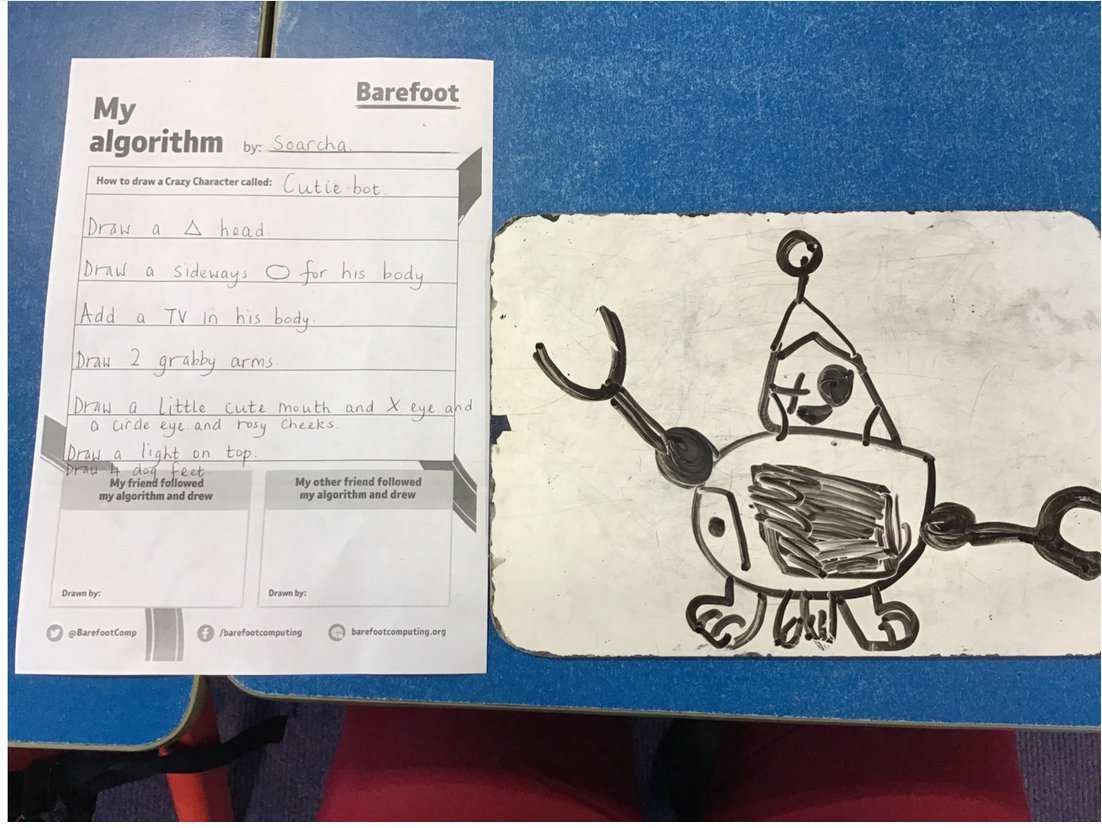
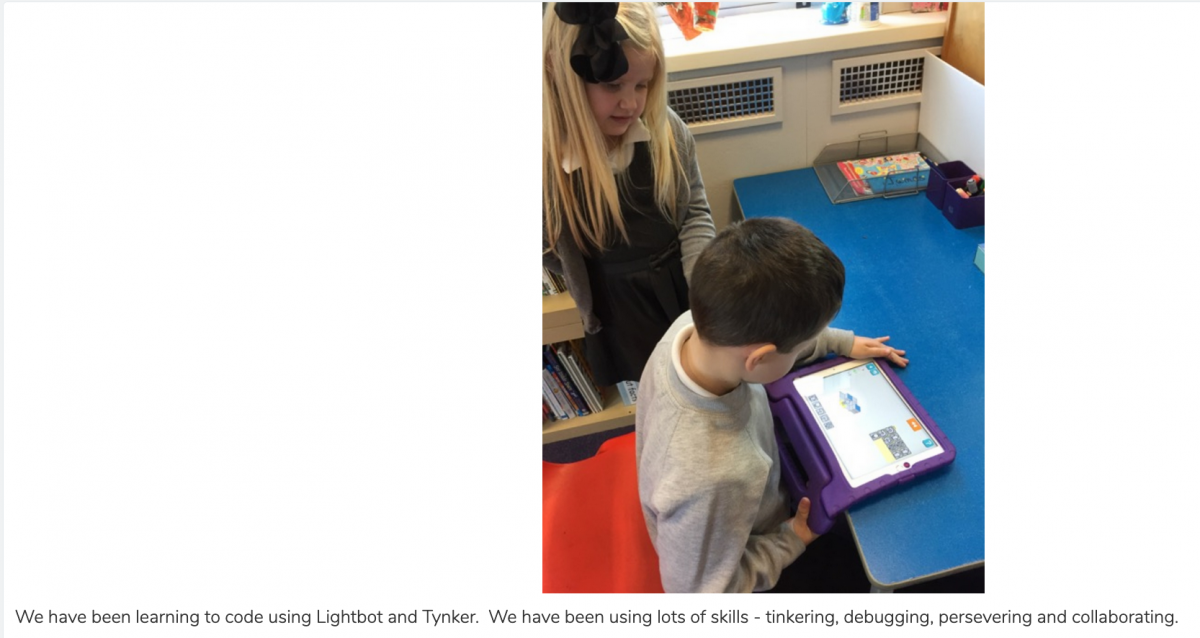
We found there were lots of online resources that worked well even down to Early years and we made good use of them- lots of tinkering going on!
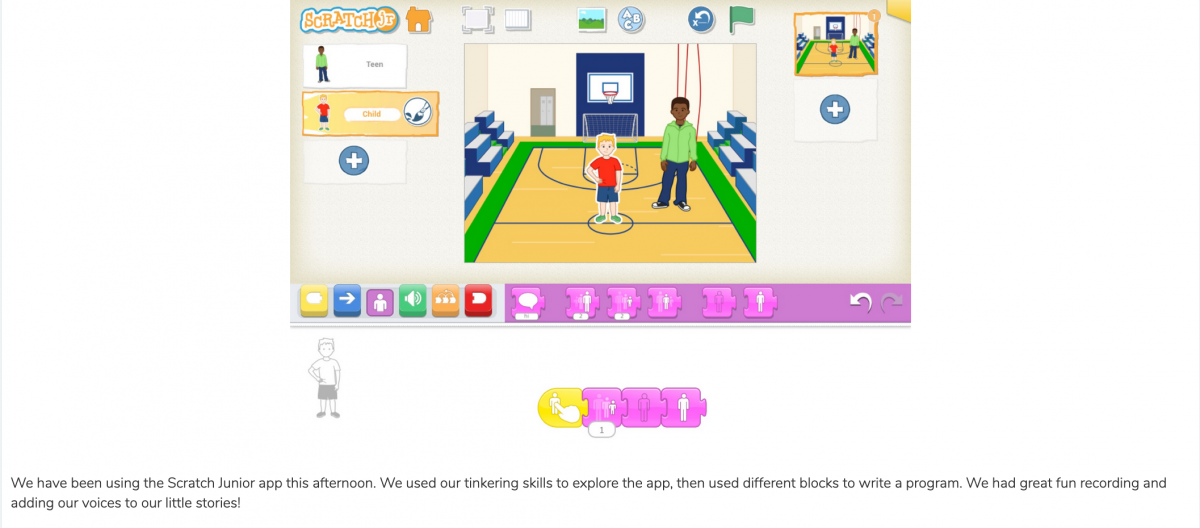
We made maps for the robots to move around and made them flash and play music as well as they followed the algorithms.
We then came up with our own designs for robots using engineering design principles and built them out of junk.
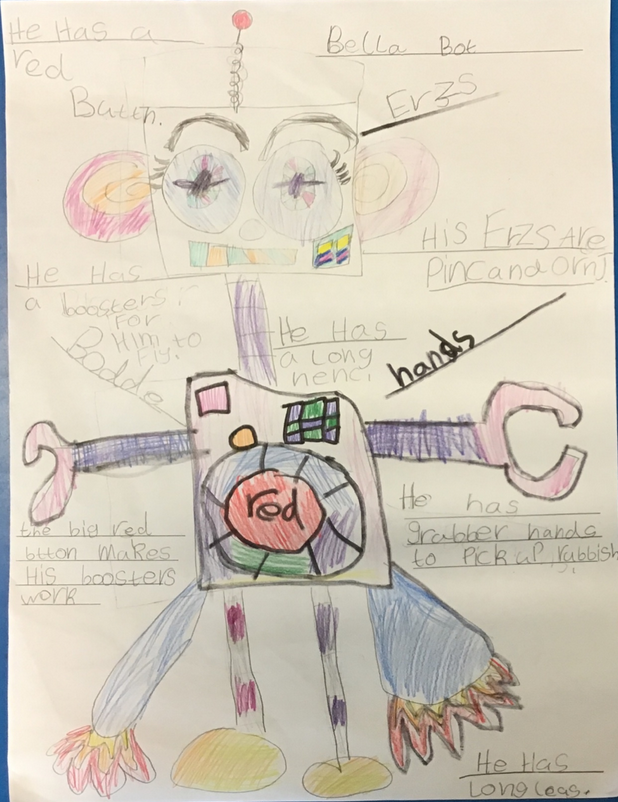

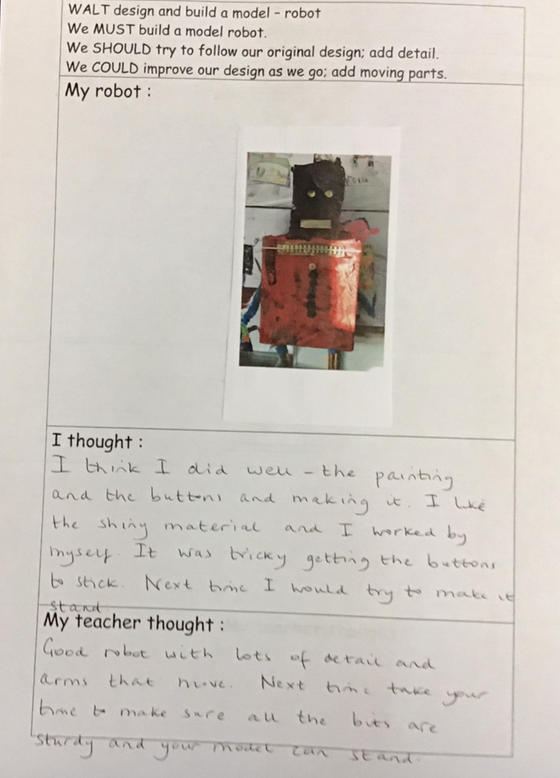
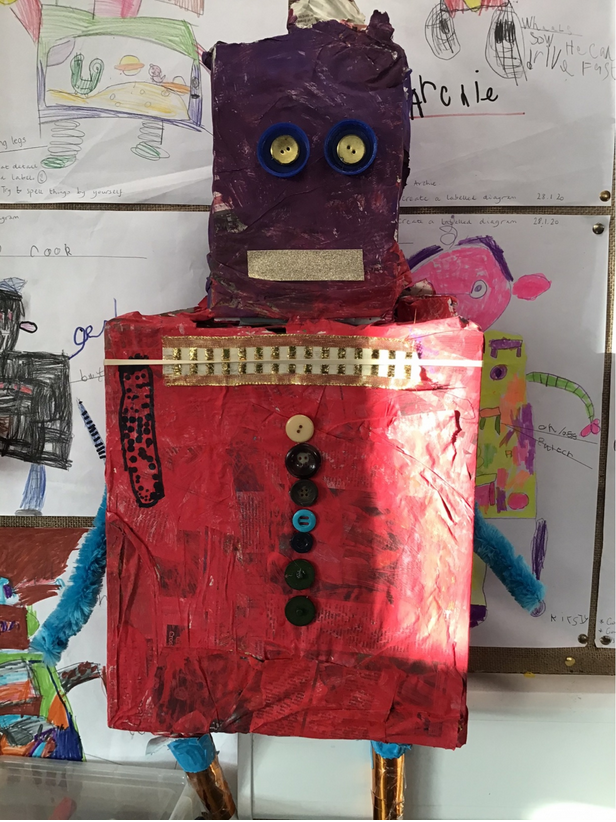
We think the robots looked fantastic!
Primary 3/4/5 have also been learning about robots and designing their own. They learned about computational thinking and applied their skills making jam sandwiches and in Scratch. They experimented with different robots like Spheros and Dash and dot. With help from P67 they learned how to program Microbits to record temperatures and used this as a data handling high quality maths assessment.
First they designed their robots using engineering and iteration.
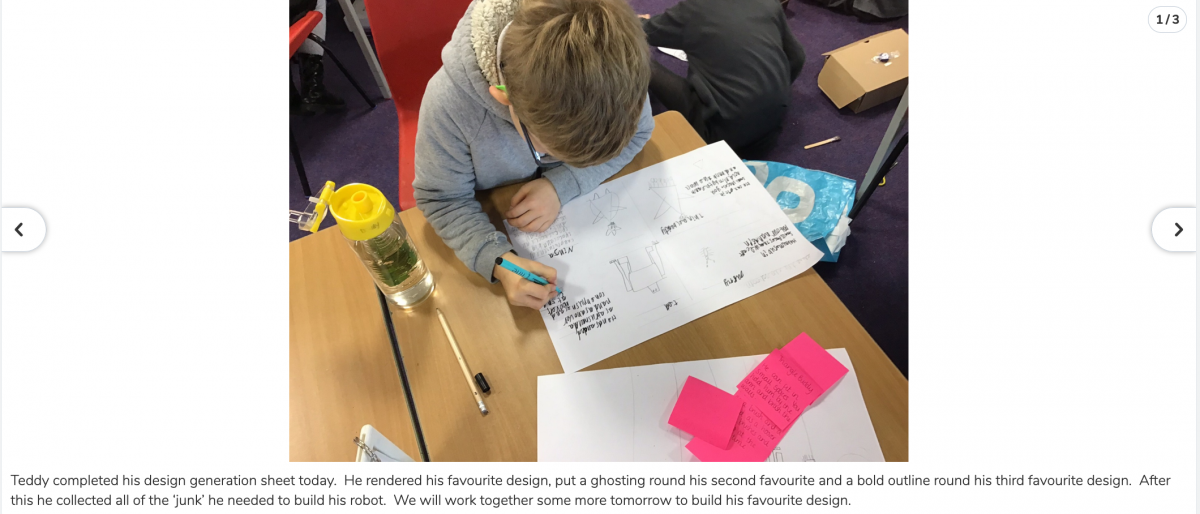
They then chose to program their microbits as part of their final robot design. The builds were very imaginative.
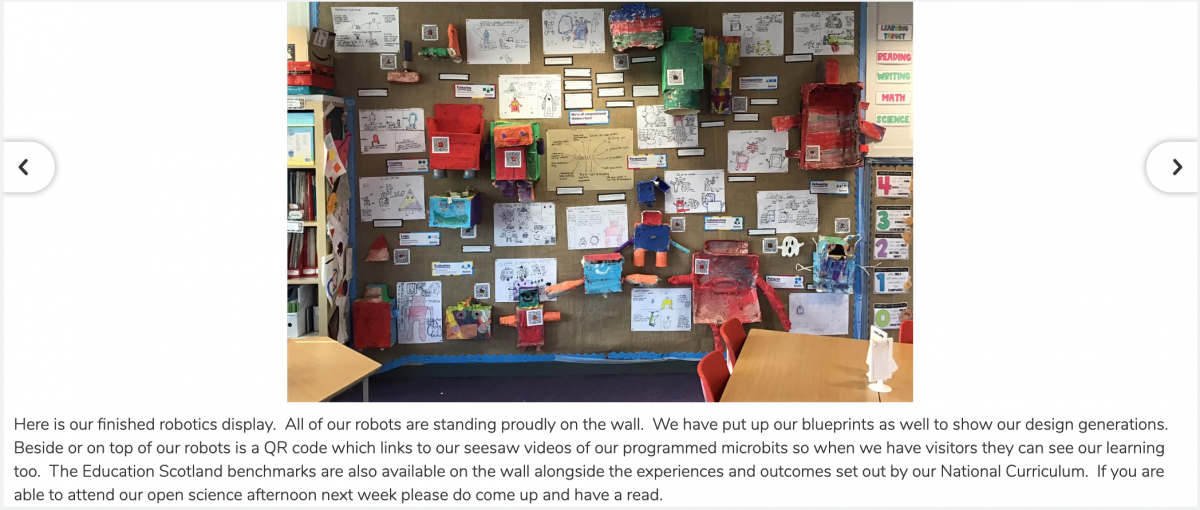
With more experience of coding through Scratch and hour of code, P67 were able to take on more challenge. They learned to use blocks rather than tracks to code the Spheros and were able to use them in maths to learn about angles in polygons by programming them to draw shapes using conditionals and loops, also programming games. They then learned how to program Microbits.
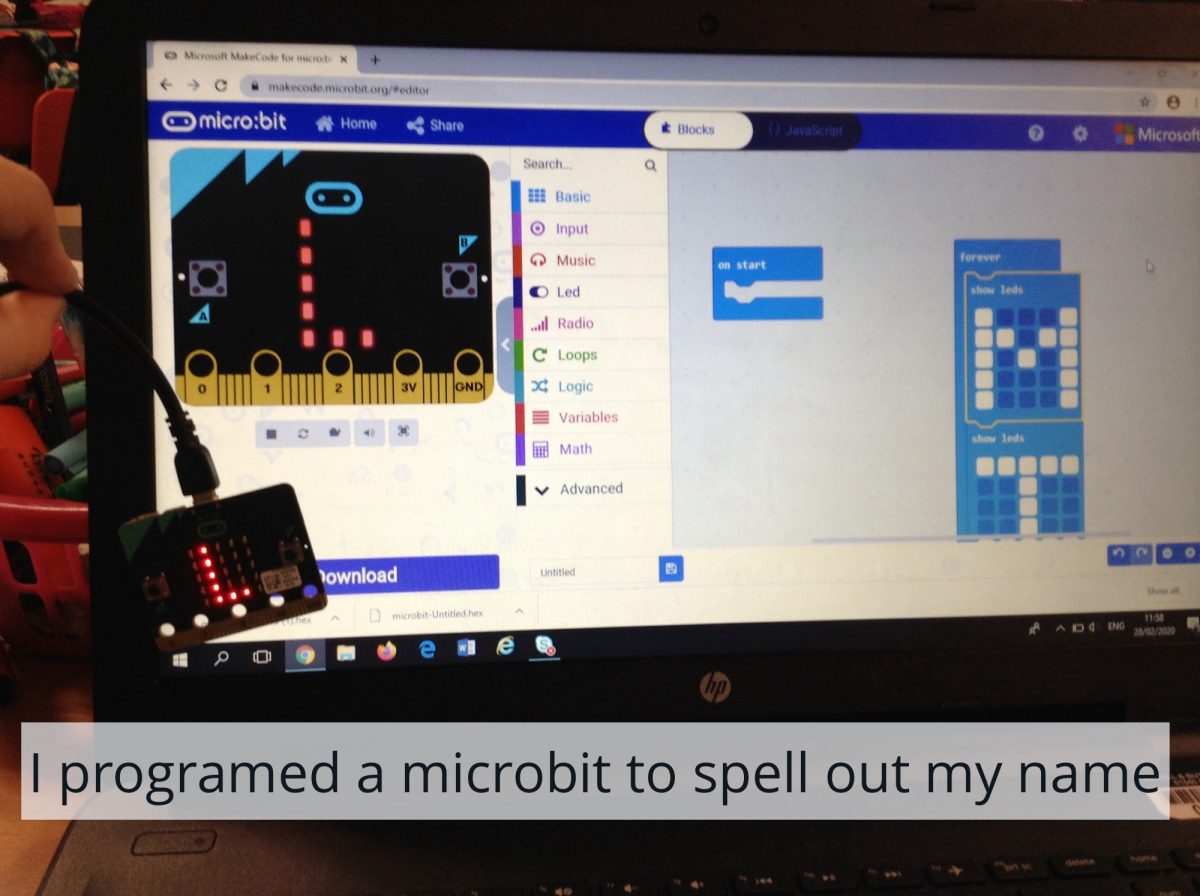
Their final challenge was to look at Robotics holistically and design a robot to solve one of the world’s/Islay’s problems by using the sustainable development goals as a framework. I adapted a Sway I found to structure their learning and used the great new tools on the new Microbit website which include programming based around the SDGs.
The children then used a design sheet to plan their robots.
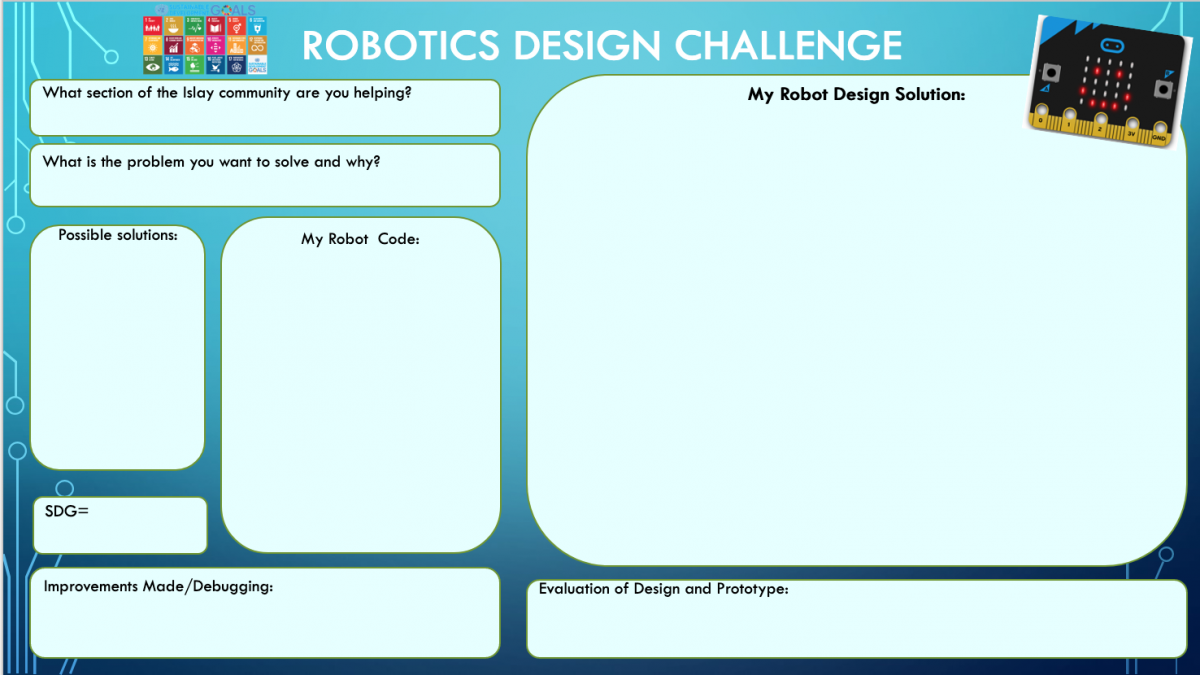
For the elderly of Islay we had robots that were pedometers designed to help them keep fit and robots that made an alarm if the temperature got too cold to warn you it was icy out. For children we had a robot that timed you washing your hands to prevent Coronavirus by playing Happy Birthday and one that timed you brushing your teeth. For Farmers a child programmed a microbit to light up when dark, that could be fixed onto black Cows so they were easy to spot if on the road at night (cows are often free range on Islay!). Another light sensitive device was to warn dolphins of underwater turbines at night.
The schools designs were then all shared with parents at an open afternoon in Science week, where children had to explain, demonstrate and discuss their new found digital skills. It was clear lots of new digital skills were learned by everyone.
Robotics to solve Problems
In P67 we have been learning all about Robotics this term for our IDL. We have learned how to think like a computer and how to program a robot. Now we are going to use robots to solve problems in our local community using Microbits.
Robotics in P3/4/5

We have been doing robotics in school recently. The children have been learning to think like a computer and develop their digital language and skills. They have learnt how to code a robot using block code using microbits, spheros and dash.
They then had to design and build their own junk model model robot with a microbot to solve a problem in our classroom. One was a ‘ghost tracker’ which identified if there was a ghost in the room by changing symbols on the microbit when the model was shaked.
Follow the link below to hear how it works.
Maldives Scientist Glow Meet
 Recently we had a Glow meet with two scientist that are working about Whalesharks mainly around the Maldives. Their names where Alina Wieczorek, and Giulia. They were also telling us about; Plastic turns into miniature microplastics, and then when whalesharks eat their food, they can be possibly eating tiny microplastics which can damadge their bodies, and it can lead to death sometimes. Whalesharks eat plankton.
Recently we had a Glow meet with two scientist that are working about Whalesharks mainly around the Maldives. Their names where Alina Wieczorek, and Giulia. They were also telling us about; Plastic turns into miniature microplastics, and then when whalesharks eat their food, they can be possibly eating tiny microplastics which can damadge their bodies, and it can lead to death sometimes. Whalesharks eat plankton.
The scientists also said that when the Whalesharks eat plankton, the plankton may already have plastic inside of it, so when they eat it they are eating plankton but also some plastic/or microplastics.
There was also something about a Whaleshark and its baby, and the mother was staying with its baby, even though the baby just recently died because of the milk from the mother.The milk was poisoned from the ammount of plastic the mother had recently eaten.
The two scientists were from Ireland, and Switzerland. There were also some facts we were given that we already
Global Data
 Primary 6&7 have been using a great resource so they can look at data from around the world and use it to compare life in different countries.
Primary 6&7 have been using a great resource so they can look at data from around the world and use it to compare life in different countries.
Using the Gapminder tools online they have been able to compare things like income, life expectancy and child mortality for a range of places around the world, creating their own comparison graphs on Excel.
They have also visited Dollar Street, a fantastic tool that show exactly what it means to live on one of the four income levels, no matter where in the world you live. The children have researched a family living on one of the income levels, and created a fact file. We now know a lot more about the world around us, based on facts!

Beach Clean 2019
 On Thursday 21st March the whole of Port Ellen Primary School went down to the co-op beach for a beach clean. There was also people from high school to help, they where the John Muir group, and also ReJIG. Before everyone went we got put into groups of 5. There was 10 groups. I got paired with Chloe, Katy, Christopher and Phoenix. P67 had created a survey so we could find out what the different types of plastic were that we foundon the beach. There were lots of small bits of plastic between 2.5 and 50cm long, but the biggest plastic pollutant was ropes and nets from fishing boats. You can see the results in the graph below. We collected 2 bags full of rubbish, lots of it was plastic. Altogether the school got 900 bits of plastic rubbish off the shore. When we left all the beach had was sand and seaweed.
On Thursday 21st March the whole of Port Ellen Primary School went down to the co-op beach for a beach clean. There was also people from high school to help, they where the John Muir group, and also ReJIG. Before everyone went we got put into groups of 5. There was 10 groups. I got paired with Chloe, Katy, Christopher and Phoenix. P67 had created a survey so we could find out what the different types of plastic were that we foundon the beach. There were lots of small bits of plastic between 2.5 and 50cm long, but the biggest plastic pollutant was ropes and nets from fishing boats. You can see the results in the graph below. We collected 2 bags full of rubbish, lots of it was plastic. Altogether the school got 900 bits of plastic rubbish off the shore. When we left all the beach had was sand and seaweed.

EMBEDDING STEM IN THE PRIMARY CURRICULUM
Rolls-Royce Look Back

This year Port Ellen Primary School have been in the finals of the Rolls-Royce science prize and we have had the BBC in to film us with all of our engineering that we have done over the past year. We also have a mentor called Neil Chattle and he has helped us all through the year.
Four people from this school went to the Celebration of science in Glasgow with their wind turbine and did very well. We also had a finalist in the younf Imagineers comptition and took part in the BP Stem Challenge. We have learned lots about renewables and engineering and are know much better at engineering. It has been a very successful project and I now want to be a civil engineer.
Matthew
Solar Experts

P1/2/3 enjoyed sharing their learning about solar power to visitors to our Community Open Afternoon.


OUR YEAR OF ENGINEERING SLIDE SHOW
Celebration of Engineering Event

On the 31st of May 2018 we had an engineering fair. We were showing other people our learning about engineering. We had made sections about things such as engineering new things out of Lego and K’nex and we had sections for global warming.
 There were also things to do with the STEM club. There was a simulation of the great pacific garbage patch. We were shown a video about a large net pulled by a boat that went to the great pacific garbage patch to collect as much garbage as possible. Some of us went to try and make something to collect as much of the stuff inside the simulation of the great pacific garbage patch as possible. One of the designs was a bunch of pipe cleaners with beads on them on the handles which would make it float. Then it would be pulled along to collect as much rubbish on the surface as possible.
There were also things to do with the STEM club. There was a simulation of the great pacific garbage patch. We were shown a video about a large net pulled by a boat that went to the great pacific garbage patch to collect as much garbage as possible. Some of us went to try and make something to collect as much of the stuff inside the simulation of the great pacific garbage patch as possible. One of the designs was a bunch of pipe cleaners with beads on them on the handles which would make it float. Then it would be pulled along to collect as much rubbish on the surface as possible.
In the hall there was a save the polar bears desk where two people were sitting at the desk, getting donations so they could save polar bears. There were lots of posters explaining how polar bears are endangered and how they could be saved. Just down from the polar bear desk there was the engineering endeavour table. There were four people. The first person was doing mechanical engineering, the second person was doing coding engineering the third person was doing electrical engineering and the fourth person was doing biomedical engineering.
It was a great day and lots of people from the community came and it was even filmed for BBC Alba.
P1/2/3 Renewables Trip


On 23rd May P1/2/3 went on a trip to see the different renewables being used in Islay. First we went to Dunlossit Estate where David Gillies showed us the biomass boiler and we saw that the store where all the wood chips were stored was like a giant slushy machine. Then we went to Ballygrant to see the hydro power station…it fitted inside a shed! Finally George Dean took us to the wind turbine and we got to go inside it. All were very intrigued by the upside down computer. Thanks to David and George for a great day.


May Diary
Renewables Engineering Islay – May Diary
As the end of our year-long project approaches there has been no slowing down here in Port Ellen….
Mentor Visit

Again, we were delighted to have our mentor, Neil Chattle, visit the school at the end of April. He toured the school to see what the children had been up to and looking at displays of their work. The children in nursery with Alison Logan were very keen that he see the boat that they’d built…and check out the tadpoles! In the afternoon Neil introduced all the children to jet engines and let them assemble amazing model engines used by apprentices at Rolls-Royce. There was lots of adrenaline running in the competition to see which team could assemble their engine fastest.
Learning about Solar Energy

P1/2/3 and Maggie Harrison have been finding out about life in rural Africa. Having read the story of Handa’s Surprise they have investigated what it’s like to live in rural Africa and how homes there don’t have electricity. Evie’s mum came in to talk to the class about her experience of living in a remote part of Tanzania and she showed the children a kerosene lamp that people might use to light their homes. The children learned how solar energy might be helpful. They built models of African homes and added solar panels and lighting – a great addition to the sand tray which was full of wild animals. They also built and tested solar ovens!
The Boy who Harnessed the Wind

Also thinking about how renewables could be used in developing countries were P4/5. They read The Boy Who Harnessed the Wind by William Kamwamba. Everyone was amazed that this was a true story of a 14 year old boy. Scott said I was surprised it was a real story. I think the boy was sad when everyone called him crazy but he showed resilience and kept working on his idea. Kate Brown used the story as a novel study and the children worked in groups to understand more about living in rural Malawi. They then watched William Kamwamba as an adult presenting his story to an audience. Kate was amazed about the impact this had on the children in her class and told us I heard one of the children at a family party tell everyone about this amazing real life story of a young boy in Malawi and the incredible things he did to help feed his village.
Gael Force Test Run
Kate Brown and the group from P4/5 tested their floating wind turbine, Gael Force, for the Knotts to Watts competition on the day that the Rolls-Royce media team visited. It was typically wild, wet and windy! The dads who had been involved in supporting the build were just as keen to see if it worked on the sea….and they were not disappoionted. The group are looking forward to seeing how the device performs in the giant wave tank when they go to Glasgow in June.
Climate Change
This month Jo Clark’s class have focused on climate change, who it affects and how we can help. They have looked at the carbon footprint of different countries and heard stories about women around the world who are working to help communities adapt to climate change. Rowan said I was surprised climate change doesn’t affect everyone equally. Poorer countries are more affected by severe weather than we are, which isn’t fair because rich countries are contributing more to climate change. Now they are working on inventions that can help save people from climate events around the world. They created climate change spiral poems for the visit of author and scientist Nicola Davies, who writes stories for children with an environmental theme.
We are Engineers

One of the main aims in the project was to raise the profile of engineering among our children. This is already showing some impact. Primary 6&7 carry out Endeavour projects every year; long term projects chosen by the children which are ambitious, look at developing new skills and have to be shared with the local community at the end. This year our focus on engineering has led to some interesting project choices. Sophie is currently building a hydraulic robot arm as part of her Endeavour on biomedical engineering. I chose this project because I think girls should be able to do engineering and I would like a job that helps people. Taylor has built a model Haynes combustion engine as part of his project on mechanical engineering; To build the model was ambitious and challenging and Donald is learning about electrical engineering and has built a capacitor circuit to store energy for the P123 class solar lights in their African huts. The same impact is being seen throughout the school. In nursery Erin asked Alison Logan Are we going to be engineering today? Jo Clark also arranged for P6/7 from Port Charlotte Primary to visit Port Ellen for some paper plane engineering!

Upcoming Events
Although this will be the final diary entry we will keep you updated on our upcoming events and continued progress with our project. George Dean is organising to take P1/2/3 to see the hydro dam, wind turbine and solar panels at the Gaelic College now that the weather is better and these younger children have a better understanding of renewable energy. The team are planning a large community event to share our journey on 29th May and Maureen MacDonald has been in discussion with BBC Alba to come along and film. Maureen is also in discussions with the council and liaising with the Islay Energy Trust about the possibility of us installing a wind turbine in the school,– a lasting legacy from this project
Budget
We have not spent any money this month so we still have £3280.99 in the budget. Alison and Maggie are planning to to buy some additional construction material for the Pre-5 unit and some solar lighting for the school; remaining money will go towards our legacy projects.
Rhys Climate Change Sway
Mega Marble Runs

Children in the ELCC have been making massive marble runs using their giant wooden blocks. The have discovered that you need to start marbles at the highest point to make them go and have had lots of opportunities to build different marble runs.
Solar Ovens


There was great excitement in P1/2/3…and a bit of envy from P4/5….as the solar ovens were used to cook marshmallows and melt chocolate digestives. Even although it was not particularly warn, we were amazed how quickly the ovens melted the chocolate and marshmallow. William is keen to cook pizza next!
African huts….using solar power

P1/2/3 have read the story of Handa’s Surprise and been learning about life in Africa. They have found out that it is very different in rural Africa from the city. They build these huts from straw, clay and wooden sticks….then added solar panels and LED lights. They were a great addition to the sand tray with all the African animals. The children learned how useful solar panels can be in helping children in rural Africa to do their homework. Evie’s mum showed the children a kerosene lamp that would be used – costly to run, dangerous and giving off nasty fumes. We researched case studies and made these Explain Everything to show what we had learned.

How strong are eggs?


We have been discovering how strong eggs are and learning to measure at the same time! Underneath this stack of books are only three eggs…..and two trays of eggs can support a small person! We were amazed when we watched a film clip of Richard Hammond balancing two crushed cars on a large array of eggs. Check it out.
Climate Change
Climate change is getting worse and worse every day because of us. Climate change is when lots of carbon emissions are released into the atmosphere which creates a lair of greenhouse gas which then traps heat in the earth causing global warming, which destroys habitats and can create tornados, tsunamis and hurricanes. This is also caused by surprisingly cows because of there farting and burping , this happens because the methane they let out.
The energy we use is also having an impact on the earth because of all the carbon emissions we use to run our homes,cars and electronics. We could change this by using renewables such as wind, solar and hydro power. We are destroying the Arctic so Polar bears and penguins won’t have habitats. So I feel that everyone needs to start using renewable energies.
You can see how global warming is happening using this climate spiral animation:

By Aidan and Jack
Nicola Davies Visit

Yesterday Nicola Davies came in to talk with us about her books as part of the Scottish Book Trust 20th Anniversary Tour. She has mostly based her stories with animals in them because before she was an author she was a zoologist and there was a book that she was telling us about and it was about a boy that got his arm pulled of by a lion, it’s name was The Lion Who Stole My Arm. The real story that it was based on was about a 5 year old boy who got attacked by a lion and even though his arm didn’t come off he had to get it amputated because the attack was so bad. She was also telling us about animals that she was looking at such as: lionesses, humpback whales etc. When she was talking to us about the humpback whales she noticed when she was studying them that mostly every day and hour of the day the whales would eat then eat then eat again. Also to have a little fun we learned how to sing like a whale. Nicola Davies also wrote a climate change book called Gaiya and because we are doing climate change as one of out topics that was very interesting. We also wrote climate change poems. We have been researching a lot of different facts and effects that climate change has on the world. We could either write a kenning, a haiku or a free verse poem. We thought that the visit as very exciting learning about lots of different animals.
By Rebecca and Rowan
Building jet engines


Neil Chattle, our Rolls-Royce mentor, visited the school on 26th April. He gave a talk to the whole school about jet engines and brought some model jet engines for us to try building. We had a great day and ended with a challenge for teams of children to work together to build the model engine in the fastest possible time!


Egg Engineering
This term we where doing Egg Engineering. We made parachutes and cars. We tested the cars the day after we made them in teams with other classes. Our class made parachutes for our eggs. Nearly all of our eggs lived, only 3 cracked. The egg cars were a success!Four cars passed the finish line on the day. Some of the cars went through the tunnel and some did not because they were too big.
Phoenix and Robyn

April Diary
Renewables Engineering Islay – April Diary
With Easter on the horizon the team decided that we’d do a bit of…..
Egg Engineering
All the children in the school have been finding out about the strength of eggs. P1/2/3 and the Pre-5 unit were amazed to watch a video clip showing that a huge tray of eggs could support the weight of two cars! In their joint play session they investigated to see if eggs could hold up a person. Primary children then engineered different ways to drop an egg without them breaking, learning about gravity and air resistance along the way. There were lots of parachutes……but also trampolines and some very innovative but simple designs. Primary 6/7 used Newton’s three laws when thinking about their engineering designs. Throughout the build the children were encouraged to think like engineers and use the engineering process to imagine, plan, create and improve on their designs. Since the whole school were involved in this, we used this as an opportunity to use maths skills within an engineering context. Children measured length, weight and volume of eggs. They worked out the area of parachutes and time taken for eggs to drop. Primary 6/7 children also calculated the speed of descent. At the end of the week the children worked in cross-stage groups to design and build wind-powered cars. We showed the children the incredible Theo Jansen strandbeests to inspire them. Parents were then invited to join us for the final testing seeing which vehicle went furthest, fastest and could cope with a tricky obstacle course while keeping the egg secure. Connor, P3, said It’s been great fun this week because we were building stuff and building is my thing. Ellen thought it was great fun and I liked how we got all the parents in. Aiden said I enjoyed racing the cars and learning all about friction and things.

Maureen MacDonald spoke to the parents about the Rolls-Royce Science Prize and what a great experience it had been for the school. She also said that we were planning a community event to celebrate all the work that had been done over the past few months.
Parents were also encouraged to do a little engineering themselves, building rafts to support an egg. It proved to be trickier than we thought! Comments from parents included Amazing experience for all the children with so much fun and learning, loved the teamwork, Well done Port Ellen Primary – what an interesting project, Fantastic – hope it encourages lots of budding engineers.

Knotts to Watts
Kate Brown and P4/5 have also had great parental involvement in helping to build a prototype floating wind turbine for the Knotts to Watts competition. It was very exciting for the children to see their own designs and models being scaled up and fantastic to have the support of a couple of dads. For two afternoons Dearbhla’s dad and Morgan’s dad worked with the group to develop the children’s design. It is very innovative with two turbine heads. Initial testing in the classroom got the blades turning and it did produce electricity. The class are looking forward to testing it out in the sea next week. The whole school is very proud that the group have been invited to test their design in a wave tank as part of the Young Scientists and Engineers event in Glasgow in June.
Gus Newman, one of the parents, commented I enjoy coming in to school and working with the young ones and getting them involved in future technology. I really like seeing their creativity.

Nuts and Bolts
The Parent Council are very supportive of everything that we do in school. They have helped us to set up our Nuts and Bolts shed in the playground. This is based around the idea of a scrap store with nets, ropes, crates, creels etc. The children have had great fun building lots of new things using the fish boxes donated by Drew’s dad. Kate Brown has taken responsibility for sourcing material for the shed…and we are hoping to build on this in the future. In the nursery outdoor play area Alison Logan has had dads in to develop a system of water chutes for children to explore.

STEM Homelinks
Maggie Harrison and Maureen MacDonald are thinking about how we move forward as a school after the Rolls-Royce project is over. We have started to use a STEM self-evaluation tool to help us. One of things we would like to improve is parental engagement with STEM. Maggie, in her role as Primary Cluster Mentor, has been working with two colleagues from other primary schools and as a team they have agreed to develop a series of STEM bags that can be sent home with activities that children can do with their parents.
Budget
Since we have been on holiday for two weeks we have had no outgoing this month so we still have £3280.99 in the budget. The children have expressed an interest in getting a wind turbine for the school and are in contact with George Dean to see how we could go about this.


